Toshiba ML3054 User Manual

User’s Manual
Qosmio F50 Series

Table of Contents
Copyright. . . . . . . . . . . . . . . . . . . . . . . . . . . . . . . . . . . . . . . . . . . . . . . . . vi Disclaimer . . . . . . . . . . . . . . . . . . . . . . . . . . . . . . . . . . . . . . . . . . . . . . . . vi Trademarks . . . . . . . . . . . . . . . . . . . . . . . . . . . . . . . . . . . . . . . . . . . . . . . vii Macrovision License . . . . . . . . . . . . . . . . . . . . . . . . . . . . . . . . . . . . . . . vii FCC information . . . . . . . . . . . . . . . . . . . . . . . . . . . . . . . . . . . . . . . . . . viii EU Conformity Statement . . . . . . . . . . . . . . . . . . . . . . . . . . . . . . . . . . . ix VCCI Class B Information . . . . . . . . . . . . . . . . . . . . . . . . . . . . . . . . . . . ix Important Safety Information for Computers with TV tuner . . . . . . . . ix Modem warning notice. . . . . . . . . . . . . . . . . . . . . . . . . . . . . . . . . . . . . . . x Japan regulations . . . . . . . . . . . . . . . . . . . . . . . . . . . . . . . . . . . . . . . . . . . x Instructions for IC CS-03 certified equipment . . . . . . . . . . . . . . . . . . xiii Notes for Users in Australia and New Zealand . . . . . . . . . . . . . . . . . xiv Optical disc drive safety instructions. . . . . . . . . . . . . . . . . . . . . . . . xviii International precautions. . . . . . . . . . . . . . . . . . . . . . . . . . . . . . . . . . . xxi
Preface
Conventions . . . . . . . . . . . . . . . . . . . . . . . . . . . . . . . . . . . . . . . . . . . . xxiii
General Precautions
Provide adequate ventilation. . . . . . . . . . . . . . . . . . . . . . . . . . . . . . . xxvi Creating a computer-friendly environment . . . . . . . . . . . . . . . . . . . xxvii Stress injury . . . . . . . . . . . . . . . . . . . . . . . . . . . . . . . . . . . . . . . . . . . . xxvii Heat injury . . . . . . . . . . . . . . . . . . . . . . . . . . . . . . . . . . . . . . . . . . . . . . xxvii Pressure or impact damage. . . . . . . . . . . . . . . . . . . . . . . . . . . . . . . xxviii Mobile phones . . . . . . . . . . . . . . . . . . . . . . . . . . . . . . . . . . . . . . . . . xxviii Instruction Manual for Safety and Comfort . . . . . . . . . . . . . . . . . . xxviii The cautions on use of a Qosmio F50 series computer . . . . . . . . xxviii
Chapter 1 Introduction
Equipment checklist. . . . . . . . . . . . . . . . . . . . . . . . . . . . . . . . . . . . . . . 1-1 Hardware . . . . . . . . . . . . . . . . . . . . . . . . . . . . . . . . . . . . . . . . . . . . . . . . 1-3 Special features . . . . . . . . . . . . . . . . . . . . . . . . . . . . . . . . . . . . . . . . . 1-12 TOSHIBA Value Added Package . . . . . . . . . . . . . . . . . . . . . . . . . . . . 1-14
User’s Manual |
ii |

Qosmio F50
Utilities and Applications. . . . . . . . . . . . . . . . . . . . . . . . . . . . . . . . . . 1-16 Optinal accessories . . . . . . . . . . . . . . . . . . . . . . . . . . . . . . . . . . . . . . 1-20
Chapter 2 The Grand Tour
Front with the display closed . . . . . . . . . . . . . . . . . . . . . . . . . . . . . . . 2-1 Left side . . . . . . . . . . . . . . . . . . . . . . . . . . . . . . . . . . . . . . . . . . . . . . . . . 2-3 Right side . . . . . . . . . . . . . . . . . . . . . . . . . . . . . . . . . . . . . . . . . . . . . . . 2-4 Back . . . . . . . . . . . . . . . . . . . . . . . . . . . . . . . . . . . . . . . . . . . . . . . . . . . . 2-5 Underside . . . . . . . . . . . . . . . . . . . . . . . . . . . . . . . . . . . . . . . . . . . . . . . 2-8 Front with the display open. . . . . . . . . . . . . . . . . . . . . . . . . . . . . . . . . 2-9 System indicators. . . . . . . . . . . . . . . . . . . . . . . . . . . . . . . . . . . . . . . . 2-12 Optical disc drives . . . . . . . . . . . . . . . . . . . . . . . . . . . . . . . . . . . . . . . 2-14 AC adaptor . . . . . . . . . . . . . . . . . . . . . . . . . . . . . . . . . . . . . . . . . . . . . 2-16
Chapter 3 Getting Started
Connecting the AC adaptor . . . . . . . . . . . . . . . . . . . . . . . . . . . . . . . . . 3-2 Opening the display . . . . . . . . . . . . . . . . . . . . . . . . . . . . . . . . . . . . . . . 3-5 Turning on the power . . . . . . . . . . . . . . . . . . . . . . . . . . . . . . . . . . . . . . 3-6 Starting up for the first time . . . . . . . . . . . . . . . . . . . . . . . . . . . . . . . . 3-7 Turning off the power. . . . . . . . . . . . . . . . . . . . . . . . . . . . . . . . . . . . . . 3-7 Restarting the computer . . . . . . . . . . . . . . . . . . . . . . . . . . . . . . . . . . 3-11 System Recovery Options . . . . . . . . . . . . . . . . . . . . . . . . . . . . . . . . . 3-12 System Recovery . . . . . . . . . . . . . . . . . . . . . . . . . . . . . . . . . . . . . . . . 3-12
Chapter 4 Operating Basics
Using the Touch Pad . . . . . . . . . . . . . . . . . . . . . . . . . . . . . . . . . . . . . . 4-1 AV Controller. . . . . . . . . . . . . . . . . . . . . . . . . . . . . . . . . . . . . . . . . . . . . 4-2 Using the Fingerprint Sensor . . . . . . . . . . . . . . . . . . . . . . . . . . . . . . . 4-2 Web Camera . . . . . . . . . . . . . . . . . . . . . . . . . . . . . . . . . . . . . . . . . . . . . 4-9 Using TOSHIBA Face Recognition . . . . . . . . . . . . . . . . . . . . . . . . . . 4-11 Using optical disk drives . . . . . . . . . . . . . . . . . . . . . . . . . . . . . . . . . . 4-14 Writng CD/DVD on DVD Super Multi drives . . . . . . . . . . . . . . . . . . . 4-18 Media care . . . . . . . . . . . . . . . . . . . . . . . . . . . . . . . . . . . . . . . . . . . . . . 4-30 TV Tuner . . . . . . . . . . . . . . . . . . . . . . . . . . . . . . . . . . . . . . . . . . . . . . . 4-32 Sound system . . . . . . . . . . . . . . . . . . . . . . . . . . . . . . . . . . . . . . . . . . . 4-33 Modem . . . . . . . . . . . . . . . . . . . . . . . . . . . . . . . . . . . . . . . . . . . . . . . . . 4-35 Wireless communications . . . . . . . . . . . . . . . . . . . . . . . . . . . . . . . . . 4-39 LAN . . . . . . . . . . . . . . . . . . . . . . . . . . . . . . . . . . . . . . . . . . . . . . . . . . . 4-42 Cleaning the computer. . . . . . . . . . . . . . . . . . . . . . . . . . . . . . . . . . . . 4-44 Moving the computer . . . . . . . . . . . . . . . . . . . . . . . . . . . . . . . . . . . . . 4-45
Chapter 5 The Keyboard
Typewriter keys. . . . . . . . . . . . . . . . . . . . . . . . . . . . . . . . . . . . . . . . . . . 5-1 Function keys: F1 … F12 . . . . . . . . . . . . . . . . . . . . . . . . . . . . . . . . . . 5-2 Soft keys: FN key combinations . . . . . . . . . . . . . . . . . . . . . . . . . . . . . 5-2 Hot keys. . . . . . . . . . . . . . . . . . . . . . . . . . . . . . . . . . . . . . . . . . . . . . . . . 5-3 Windows special keys . . . . . . . . . . . . . . . . . . . . . . . . . . . . . . . . . . . . . 5-5
User’s Manual |
iii |

|
|
Qosmio F50 |
|
Keypad overlay . . . . . . . . . . . . . . . . . . . . . . . . . . . . . . . . . . . . . |
. . . . . . 5-6 |
|
Generating ASCII characters. . . . . . . . . . . . . . . . . . . . . . . . . . |
. . . . . . 5-7 |
Chapter 6 |
Power |
|
|
Power conditions . . . . . . . . . . . . . . . . . . . . . . . . . . . . . . . . . . . . |
. . . . . 6-1 |
|
Power indicators. . . . . . . . . . . . . . . . . . . . . . . . . . . . . . . . . . . . . |
. . . . . 6-2 |
|
Battery types. . . . . . . . . . . . . . . . . . . . . . . . . . . . . . . . . . . . . . . . |
. . . . . 6-3 |
|
Care and use of the battery pack . . . . . . . . . . . . . . . . . . . . . . . |
. . . . . 6-5 |
|
Replacing the battery pack . . . . . . . . . . . . . . . . . . . . . . . . . . . . |
. . . . . 6-9 |
|
TOSHIBA Password Utility. . . . . . . . . . . . . . . . . . . . . . . . . . . . . |
. . . . 6-11 |
|
Power-up modes. . . . . . . . . . . . . . . . . . . . . . . . . . . . . . . . . . . . . |
. . . . 6-12 |
|
Panel power on/off . . . . . . . . . . . . . . . . . . . . . . . . . . . . . . . . . . . |
. . . . 6-13 |
|
System automatic Sleep/Hibernation . . . . . . . . . . . . . . . . . . . . |
. . . . 6-13 |
Chapter 7 |
HW Setup |
|
|
Accessing HW Setup . . . . . . . . . . . . . . . . . . . . . . . . . . . . . . . . . |
. . . . . 7-1 |
|
HW Setup Window . . . . . . . . . . . . . . . . . . . . . . . . . . . . . . . . . . . |
. . . . . 7-1 |
Chapter 8 |
AV functions |
|
|
Media Center . . . . . . . . . . . . . . . . . . . . . . . . . . . . . . . . . . . . . . . . |
. . . . . 8-1 |
|
Front operation panel. . . . . . . . . . . . . . . . . . . . . . . . . . . . . . . . . |
. . . . . 8-2 |
|
Remote Controller . . . . . . . . . . . . . . . . . . . . . . . . . . . . . . . . . . . |
. . . . . 8-5 |
|
Using the Remote Controller. . . . . . . . . . . . . . . . . . . . . . . . . . . |
. . . . 8-12 |
|
Installing/Removing batteries . . . . . . . . . . . . . . . . . . . . . . . . . . |
. . . . 8-13 |
|
Set-top box Connection Method and Watching TV on the |
|
|
Media Center . . . . . . . . . . . . . . . . . . . . . . . . . . . . . . . . . . . . . . . . |
. . . . 8-17 |
|
Listen to radio. . . . . . . . . . . . . . . . . . . . . . . . . . . . . . . . . . . . . . . |
. . . . 8-19 |
|
QosmioEngine . . . . . . . . . . . . . . . . . . . . . . . . . . . . . . . . . . . . . . |
. . . . 8-20 |
Chapter 9 |
Optional Devices |
|
|
ExpressCard . . . . . . . . . . . . . . . . . . . . . . . . . . . . . . . . . . . . . . . . |
. . . . . 9-2 |
|
Bridge media slot . . . . . . . . . . . . . . . . . . . . . . . . . . . . . . . . . . . . |
. . . . . 9-3 |
|
Media care . . . . . . . . . . . . . . . . . . . . . . . . . . . . . . . . . . . . . . . . . . |
. . . . . 9-6 |
|
Additional memory module . . . . . . . . . . . . . . . . . . . . . . . . . . . . |
. . . . . 9-9 |
|
Battery Packs . . . . . . . . . . . . . . . . . . . . . . . . . . . . . . . . . . . . . . . |
. . . . 9-13 |
|
Universal AC Adaptor . . . . . . . . . . . . . . . . . . . . . . . . . . . . . . . . |
. . . . 9-13 |
|
Battery Charger . . . . . . . . . . . . . . . . . . . . . . . . . . . . . . . . . . . . . |
. . . . 9-13 |
|
USB floppy diskette drive . . . . . . . . . . . . . . . . . . . . . . . . . . . . . |
. . . . 9-14 |
|
eSATA (External Serial ATA) . . . . . . . . . . . . . . . . . . . . . . . . . . . |
. . . . 9-16 |
|
External monitor . . . . . . . . . . . . . . . . . . . . . . . . . . . . . . . . . . . . . |
. . . . 9-17 |
|
HDMI . . . . . . . . . . . . . . . . . . . . . . . . . . . . . . . . . . . . . . . . . . . . . . |
. . . . 9-18 |
|
i.LINK (IEEE1394). . . . . . . . . . . . . . . . . . . . . . . . . . . . . . . . . . . . |
. . . . 9-20 |
|
Security lock . . . . . . . . . . . . . . . . . . . . . . . . . . . . . . . . . . . . . . . . |
. . . . 9-22 |
Chapter 10 |
Troubleshooting |
|
|
Problem solving process. . . . . . . . . . . . . . . . . . . . . . . . . . . . . . |
. . . . 10-1 |
|
Hardware and system checklist . . . . . . . . . . . . . . . . . . . . . . . . |
. . . . 10-3 |
|
TOSHIBA support . . . . . . . . . . . . . . . . . . . . . . . . . . . . . . . . . . . . |
. . . 10-25 |
User’s Manual |
iv |

Qosmio F50
Chapter 11 Legal Footnotes
CPU*1. . . . . . . . . . . . . . . . . . . . . . . . . . . . . . . . . . . . . . . . . . . . . . . . . . 11-1 Memory (Main System)*2 . . . . . . . . . . . . . . . . . . . . . . . . . . . . . . . . . . 11-2 Battery Life*3 . . . . . . . . . . . . . . . . . . . . . . . . . . . . . . . . . . . . . . . . . . . 11-3 Hard Disk Drive (HDD) Capacity*4 . . . . . . . . . . . . . . . . . . . . . . . . . . 11-3 LCD*5. . . . . . . . . . . . . . . . . . . . . . . . . . . . . . . . . . . . . . . . . . . . . . . . . . 11-3 Graphics Processor Unit ("GPU”)*6 . . . . . . . . . . . . . . . . . . . . . . . . . 11-3 Wireless LAN*7 . . . . . . . . . . . . . . . . . . . . . . . . . . . . . . . . . . . . . . . . . . 11-3 Non-applicable Icons*8 . . . . . . . . . . . . . . . . . . . . . . . . . . . . . . . . . . . 11-4
Copy Protection*9 . . . . . . . . . . . . . . . . . . . . . . . . . . . . . . . . . . . . . . . 11-4 TV Tuner*10. . . . . . . . . . . . . . . . . . . . . . . . . . . . . . . . . . . . . . . . . . . . . 11-4 Images*11 . . . . . . . . . . . . . . . . . . . . . . . . . . . . . . . . . . . . . . . . . . . . . . 11-4 LCD Brightness and Eye Stain*12. . . . . . . . . . . . . . . . . . . . . . . . . . . 11-4 Safety Use for TV Tuner*13 . . . . . . . . . . . . . . . . . . . . . . . . . . . . . . . . 11-4
Appendix A Specifications
Physical Dimensions . . . . . . . . . . . . . . . . . . . . . . . . . . . . . . . . . . . . . . A-1
Appendix B Display Controller and Video modes
Display controller . . . . . . . . . . . . . . . . . . . . . . . . . . . . . . . . . . . . . . . . . B-1 Video modes . . . . . . . . . . . . . . . . . . . . . . . . . . . . . . . . . . . . . . . . . . . . . B-1
Appendix C Wireless LAN
Card Specifications . . . . . . . . . . . . . . . . . . . . . . . . . . . . . . . . . . . . . . . C-1 Radio Characteristics. . . . . . . . . . . . . . . . . . . . . . . . . . . . . . . . . . . . . . C-2 Supported Frequency Sub-bands. . . . . . . . . . . . . . . . . . . . . . . . . . . . C-2
Appendix D Bluetooth wireless technology Interoperability
Bluetooth wireless technology and your Health . . . . . . . . . . . . . . . . D-2 Regulatory statements . . . . . . . . . . . . . . . . . . . . . . . . . . . . . . . . . . . . . D-2 Using Bluetooth® Card from TOSHIBA equipment in Japan . . . . . . D-5
Appendix E AC Power Cord and Connectors
Certification agencies . . . . . . . . . . . . . . . . . . . . . . . . . . . . . . . . . . . . . E-1
Appendix F Usage Restrictions
Glossary
Index
User’s Manual |
v |

Qosmio F50
Copyright
© 2008 by TOSHIBA Corporation. All rights reserved. Under the copyright laws, this manual cannot be reproduced in any form without the prior written permission of TOSHIBA. No patent liability is assumed, with respect to the use of the information contained herein.
TOSHIBA Qosmio F50 Portable Personal Computer User’s Manual
First edition June 2008
Copyright authority for music, movies, computer programs, databases and other intellectual property covered by copyright laws belongs to the author or to the copyright owner. Copyrighted material can be reproduced only for personal use or use within the home. Any other use beyond that stipulated above (including conversion to digital format, alteration, transfer of copied material and distribution on a network) without the permission of the copyright owner is a violation of copyright or author's rights and is subject to civil damages or criminal action. Please comply with copyright laws in making any reproduction from this manual.
Please note that you may infringe the owner's rights protected by the copyright laws if you use the screen mode switching functions (e.g. Wide mode, Wide Zoom mode, etc.) of this product to display enlarged images/video at coffee shops or hotels for the purposes of profits or providing these to the public.
Disclaimer
This manual has been validated and reviewed for accuracy. The instructions and descriptions it contains are accurate for the TOSHIBA Qosmio F50 Portable Personal Computers at the time of this manual’s production. However, succeeding computers and manuals are subject to change without notice. TOSHIBA assumes no liability for damages incurred directly or indirectly from errors, omissions or discrepancies between the computer and the manual.
User’s Manual |
vi |

Qosmio F50
Trademarks
IBM is a registered trademark and IBM PC is a trademark of International Business Machines Corporation.
Intel, Intel SpeedStep, Intel® CoreTM, Celeron and Centrino are trademarks or registered trademarks of Intel Corporation.
Windows, Microsoft and Windows Vista® are registered trademarks of Microsoft Corporation.
Photo CD is a trademark of Eastman Kodak.
Bluetooth is a trademark or registered trademark owned by its proprietor and used by TOSHIBA under license.
Memory Stick is a registered trademark and i.LINK is a trademark of Sony Corporation.
DVD MovieFactory is a registered trademarks of Ulead Systems, Inc. Labelflash is a trademark of YAMAHA CORPORATION.
Manufactured under license from Dolby Laboratories.
Dolby and the double-D symbol are trademarks of Dolby Laboratories. Dolby Home Theater is a trademark of Dolby Laboratories.
PalmCheck and TouchPad are trademarks of Synaptics Incorporated. ExpressCard is a trademark of PCMCIA.
ConfigFree is a trademark of Toshiba Corporation. Wi-Fi is a registered trademark of the Wi-Fi Alliance.
Secure Digital and SD are trademarks of SD Card Association. MultiMediaCard and MMC are trademarks of MultiMediaCard Association. xD-Picture Card is a trademark of FUJIFILM Corporation.
Other trademarks and registered trademarks not listed above may be used in this manual.
Macrovision License
This product includes copyright protection technology and intellectual property that are patented in the U.S. and other countries. These patents are the property of Macrovision Corporation. The use of copyright protection must be authorized by Macrovision Corporation. It is intended for home and other restricted-use applications, unless Macrovision Corporation expressly authorizes otherwise. All forms of reverse engineering or decompiling are forbidden.
User’s Manual |
vii |

Qosmio F50
FCC information
FCC notice "Declaration of Conformity Information"
This equipment has been tested and found to comply with the limits for a Class B digital device, pursuant to part 15 of the FCC rules. These limits are designed to provide reasonable protection against harmful interference in a residential installation. This equipment generates, uses and can radiate radio frequency energy and, if not installed and used in accordance with the instructions, may cause harmful interference to radio communications. However, there is no guarantee that interference will not occur in a particular installation. If this equipment does cause harmful interference to radio or television reception, which can be determined by turning the equipment off and on, the user is encouraged to try to correct the interference by one or more of the following measures:
■Reorient or relocate the receiving antenna.
■Increase the separation between the equipment and receiver.
■Connect the equipment into an outlet on a circuit different from that to which the receiver is connected.
■Consult the dealer or an experienced radio/TV technician for help.
Only peripherals complying with the FCC class B limits may be attached to this equipment. Operation with non-compliant peripherals or peripherals not recommended by TOSHIBA is likely to result in interference to radio and TV reception. Shielded cables must be used between the external devices and the computer’s external monitor port, Universal Serial Bus (USB 2.0) ports, i.LINK (IEEE1394) port, HDMI out port and microphone jack. Changes or modifications made to this equipment, not expressly approved by TOSHIBA or parties authorized by TOSHIBA could void the user’s authority to operate the equipment.
FCC conditions
This device complies with part 15 of the FCC Rules. Operation is subject to the following two conditions:
1.This device may not cause harmful interference.
2.This device must accept any interference received, including interference that may cause undesired operation.
Contact
Address: TOSHIBA America Information Systems, Inc.
9740 Irvine Boulevard
Irvine, California 92618-1697
Telephone: (949) 583-3000
User’s Manual |
viii |
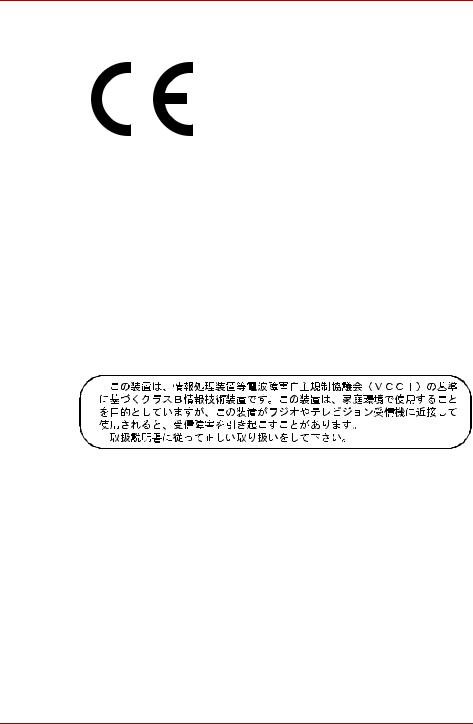
Qosmio F50
EU Conformity Statement
This product and - if applicable - the supplied accessories too are marked with "CE" and comply therefore with the applicable harmonized European standards listed under the Low Voltage Directive 2006/95/EC, the EMC Directive 2004/108/EC and/or R&TTE Directive 1999/5/EC.
Responsible for CE- |
TOSHIBA EUROPE GMBH, Hammfelddamm 8, |
marking: |
41460 Neuss, Germany. |
manufacturer: |
Toshiba Corporation, 1-1 Shibaura 1-chome, |
|
Minato-ku, Tokyo, 105-8001, Japan |
The complete official EU CE Declaration can be obtained on following internet page:
http://epps.toshiba-teg.com/
VCCI Class B Information
Important Safety Information for Computers with TV tuner
IEC60950-1/EN60950-1 Information technology equipment - Safety - Coaxial cable connection to this computer must only be used if the cable outer conductive shielding has been grounded by the cable installer at the building premises as close to the point of cable entrance, or attachment, as practicable and the connection complies with all local cable installation requirements that are applicable in your area.
User’s Manual |
ix |

Qosmio F50
Modem warning notice
This information is applicable to the models equipped with a built-in modem.
Conformity Statement
The equipment has been approved to [Commission Decision “CTR21”] for pan-European single terminal connection to the Public Switched Telephone Network (PSTN).
However, due to differences between the individual PSTNs provided in different countries/regions the approval does not, of itself, give an unconditional assurance of successful operation on every PSTN network termination point.
In the event of problems, you should contact your equipment supplier in the first instance.
Network Compatibility Statement
This product is designed to work with, and is compatible with the following networks. It has been tested to and found to conform with the additional requirements conditional in EG 201 121.
Germany |
ATAAB AN005, AN006, AN007, AN009, AN010 |
|
and DE03, 04, 05, 08, 09, 12, 14, 17 |
Greece |
ATAAB AN005, AN006 and GR01, 02, 03, 04 |
Portugal |
ATAAB AN001, 005, 006, 007, 011 and |
|
P03, 04, 08, 10 |
Spain |
ATAAB AN005, 007, 012, and ES01 |
Switzerland |
ATAAB AN002 |
All other countries/regions |
ATAAB AN003, 004 |
Specific switch settings or software setup is required for each network, please refer to the relevant sections of the user guide for more details.
The hookflash (timed break register recall) function is subject to separate national type approvals. It has not been tested for conformity to national type regulations, and no guarantee of successful operation of that specific function on specific national networks can be given.
Japan regulations
Region selection
If you are using the computer in Japan, technical regulations described under Telecommunications Business Law require that you select the Japan region mode. It is illegal to use the modem in Japan with any other selection.
User’s Manual |
x |
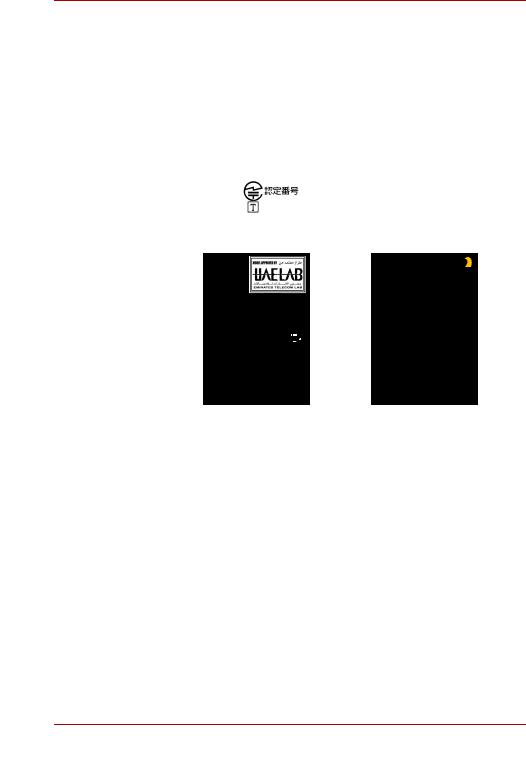
Qosmio F50
Redial
Up to two redial attempts can be made. If more than two redial attempts are made, the modem will return Black Listed. If you are experiencing problems with the Black Listed code, set the interval between redials at one minute or longer.
Japan’s Telecommunications Business Law permits up to two redials on analogue telephones, but the redials must be made within a total of three minutes.
The internal modem is approved by the Japan Approvals Institute for Telecommunications Equipment.
A05-0413001
This label is located on the module.
SUBTEL 3061
IC: 109AH-ML3054 TEC/WR/I/MOD-08/02/100.JAN 05 MOROCCO : 2903/2005
FCC NO.:US:S56MD01B13054
Model Number:ML3054
NYCE/CT/0008/06/TS
Cofetel n° : TTD:MOML06-189
POSTEL 02375/POSTEL/2007
Name of permit owner: Ronny Cabouly Telephone: 03-9506328
Model: ML3054
Manufacturer: MOTOROLA INC. Country of manufacture: USA
Type approval No.: 7-12840-0-101926 Valid from: 2004
Permit No.: 13-12840-0-101927 Valid from:2004
MOTOROLA ML3054
 54-3708
54-3708
MOTOROLA
|
|
|
|
|
|
|
|
|
|
|
|
|
|
|
|
|
|
|
|
|
|
|
|
|
|
|
|
|
|
|
|
|
|
|
|
|
|
|
|
|
|
|
|
|
|
|
|
|
|
|
|
|
|
|
|
|
|
|
|
|
|
|
|
|
|
|
|
|
|
|
|
|
|
|
|
|
|
|
|
|
|
|
|
|
|
|
|
|
|
|
|
|
|
|
|
|
|
|
|
|
|
|
|
|
|
|
|
|
|
|
|
|
|
|
|
|
|
|
|
|
|
|
|
|
|
|
|
|
|
|
|
0617-05-1699 |
|
|
|
|
|
|
|
|
|
|
|||||||
|
|
|
|
|
|
|
|
|
|
|
|
|
|
|
|
|
|
|
|
|
|
|
|
|
|
|
|
|
|
|
|
|
|
|
|
|
|
|
|
|
|
|
|
|
|
|
|
|
|
|
|
|
E04/01/211/G |
|
|
|
|
TE-A22/K012-04-0422 |
|
|
|
|
|
|
|
|
|
|
||||||
|
|
|
|
|
|
|
|
|
|
|
|
|
|
|
|
|
|
|
|
|
||||
|
|
|
|
|
|
|
|
|
|
|
|
|
|
|
|
|
E253445 |
|||||||
|
EQUIPO |
|
|
|
|
|
|
|
|
|
|
|
||||||||||||
|
HOMOLOGADO POR |
|
|
|
|
|
|
|
|
|
|
|
|
|
|
|
|
|
|
|
||||
|
ANTEL |
|
|
|
|
|
NTC |
|
|
|
|
|
|
|
|
|
|
|||||||
|
No de Aprob: MC-108 |
|
|
|
|
|
|
|
|
|
This Motorola ML3054 56k |
|
||||||||||||
|
Fecha: 20/12/2005 |
|
|
|
|
|
|
|
|
|
|
|
|
|
Modem may be connected |
|
||||||||
|
Empresa: Motorola Inc |
|
|
|
|
|
|
|
|
|
|
|
|
|
to the Telecom Network |
|
||||||||
|
|
|
Made In China |
Type Approved |
|
|
|
|
PTC / 211 / 05 / 005 |
|
|
|||||||||||||
|
|
|
No.:ESD-CPE-0400760 |
|
|
|
|
|
||||||||||||||||
|
|
|
|
|
|
|
|
|
|
|
|
|
|
|
|
|
|
|
|
|
|
|
|
|
Complies with |
|
|
|
|
|
|
|
|
|
|
|
|
|
|
|
|
|
|
|
|
|
|
|
|
IDA Standards |
|
|
|
|
|
|
|
|
|
|
|
|
|
|
|
|
|
|
|
|
|
|
|
|
DA 103255 |
|
|
|
|
|
|
|
|
|
|
|
|
|
|
|
|
|
|
|
|
|
|||
|
|
|
A05-0025001 |
|
|
|
|
|
|
|
|
|
|
|
|
|
|
|
|
|
|
|||
|
B93M1015-F |
|
|
|
|
|
|
|
|
|
|
|
|
|
|
|
|
|
|
|||||
|
|
|
TE-2004/175 |
|
|
|
|
|
|
|
|
|
|
|
|
|
|
|
|
|
|
|||
N723Z218 |
|
|
|
|
|
|
|
|
|
|
|
|
|
|
|
|
|
|
||||||


 No.#SL405007
No.#SL405007
Delphi D40 |
04604/POSTEL/2007 |
|
|
|
|
|
|
|
This Agere Delphi D40 56K |
|
|
|
|
|
|
Modem may be connected |
|
|
|
|
|
1911 |
to the Telecom Network |
|
|
|
|
|
PTC 211/05/074 |
|
A05-0413001 |
US:AGSMD01BDELPHI |
||
|
|
|
||||
|
|
|
|
|||
|
|
|
|
NYCE/CT/0003/07/TS |
||
Agere Systems |
|
Morocco: 2514/2005 |
|
No:ESD-CPE-0500938 |
N723 |
Cofetel no : TTDAGDE07-056 |
Delphi Modem D40 |
|
Factory ID: E |
|
|||
|
|
|
|
|||
Approval No. 3785 |
|
|
|
|
CCAC07M10010T6 |
|
|
|
Agere DELPHI D40(AM5) |
|
|
||
|
|
54-5681 |
|
|
||
|
|
Agere Systems Inc. |
|
|
2005/174TE- |
|
ETISALAT PERMIT NO.:E05/01/254/G |
|
Approval by PTA,2007 |
0455-06-2565 0107898349890382 |
|||
|
NCG-CE-06-009 AM5 115/06 |
|||||
|
|
|||||
|
|
TEC/WR/I/MOD-08/02/122.MAY07 |
|
|||
Certificate No.#SL405083 |
|
IC:4005B-DELPHI, REN:0.1 |
ASI-DELPHI-D40 |
|||
|
|
|||||
User’s Manual |
xi |

Qosmio F50
Pursuant to FCC CFR 47, Part 68:
When you are ready to install or use the modem, call your local telephone company and give them the following information:
■The telephone number of the line to which you will connect the modem
■The registration number that is located on the device
The FCC registration number of the modem will be found on either the device which is to be installed, or, if already installed, on the bottom of the computer, separate from the system information label.
■The Ringer Equivalence Number (REN) of the modem, which can vary - for the REN, please refer to the modem's label.
The modem connects to the telephone line by means of a standard jack called the USOC RJ11C.
Type of service
Your modem is designed to be used on standard-device telephone lines. Connection to telephone company-provided coin service (central office implemented systems) is prohibited. Connection to party lines service is subject to state tariffs. If you have any questions about your telephone line, such as how many pieces of equipment you can connect to it, the telephone company will provide this information upon request.
Telephone company procedures
The goal of the telephone company is to provide you with the best service it can. In order to do this, it may occasionally be necessary for them to make changes in their equipment, operations, or procedures. If these changes might affect your service or the operation of your equipment, the telephone company will give you notice in writing to allow you to make any changes necessary to maintain uninterrupted service.
If problems arise
If any of your telephone equipment is not operating properly, you should immediately remove it from your telephone line, as it may cause harm to the telephone network. If the telephone company notes a problem, they may temporarily discontinue service. When practical, they will notify you in advance of this disconnection. If advance notice is not feasible, you will be notified as soon as possible. When you are notified, you will be given the opportunity to correct the problem and informed of your right to file a complaint with the FCC. In the event repairs are ever needed on your modem, they should be performed by TOSHIBA Corporation or an authorized representative of TOSHIBA Corporation.
Disconnection
If you should ever decide to permanently disconnect your modem from its present line, please call the telephone company and let them know of this change.
User’s Manual |
xii |

Qosmio F50
Fax branding
The Telephone Consumer Protection Act of 1991 makes it unlawful for any person to use a computer or other electronic device to send any message via a telephone fax machine unless such a message clearly contains in a margin at the top or bottom of each transmitted page, or on the first page of the transmission, the date and time it is sent, an identification of the business, other entity or individual sending the message and the telephone number of the sending machine or such business, other entity or individual. In order to program this information into your fax modem, you should complete the setup of your fax software before sending messages.
Use only No. 26 AWG or larger telecommunication line cord.
Instructions for IC CS-03 certified equipment
1.The Industry Canada label identifies certified equipment. This certification means that the equipment meets certain telecommunications network protective, operational and safety requirements as prescribed in the appropriate Terminal Equipment Technical Requirements document(s). The Department does not guarantee the equipment will operate to the user’s satisfaction.
Before installing this equipment, users should ensure that it is permissible to be connected to the facilities of the local telecommunications company. The equipment must also be installed using an acceptable method of connection.
The customer should be aware that compliance with the above conditions may not prevent degradation of service in some situations. Repairs to certified equipment should be coordinated by a representative designated by the supplier. Any repairs or alterations made by the user to this equipment, or equipment malfunctions, may give the telecommunications company cause to request the user to disconnect the equipment.
Users should ensure for their own protection that the electrical ground connections of the power utility, telephone lines and internal metallic water pipe system, if present, are connected together. This precaution may be particularly important in rural areas.
Users should not attempt to make such connections themselves, but should contact the appropriate electric inspection authority, or electrician, as appropriate.
2.The user manual of analog equipment must contain the equipment’s Ringer Equivalence Number (REN) and an explanation notice similar to the following:
The Ringer Equivalence Number (REN) of the modem can vary - for the REN, please refer to the modem's label.
User’s Manual |
xiii |

Qosmio F50
The Ringer Equivalence Number (REN) assigned to each terminal device provides an indication of the maximum number of terminals allowed to be connected to a telephone interface. The termination on an interface may consist of any combination of devices subject only to the requirement that the sum of the Ringer Equivalence Numbers of all the devices does not exceed 5.
3.The standard connecting arrangement (telephone jack type) for this equipment is jack type(s): USOC RJ11C.
The IC registration number of the modem is shown below.
Canada: 4005B-DELPHI
Notes for Users in Australia and New Zealand
Modem warning notice for Australia
Modems connected to the Australian telecoms network must have a valid Austel permit. This modem has been designed to specifically configure to ensure compliance with Austel standards when the country/region selection is set to Australia. The use of other country/region settings while the modem is attached to the Australian PSTN would result in your modem being operated in a non-compliant manner. To verify that the country/region is correctly set, enter the command ATI which displays the currently active setting.
To set the country/region permanently to Australia, enter the following command sequence:
AT%TE=1
ATS133=1
AT&F
AT&W
AT%TE=0 ATZ
Failure to set the modem to the Australia country/region setting as shown above will result in the modem being operated in a non-compliant manner. Consequently, there would be no permit in force for this equipment, with the Telecoms Act 1991 prescribing a penalty of $12,000 for the connection of non-permitted equipment.
User’s Manual |
xiv |

Qosmio F50
Notes for use of this device in New Zealand
■The grant of a Telepermit for a device in no way indicates Telecom acceptance of responsibility for the correct operation of that device under all operating conditions. In particular the higher speeds at which this modem is capable of operating depend on a specific network implementation which is only one of many ways of delivering high quality voice telephony to customers. Failure to operate should not be reported as a fault to Telecom.
■In addition to satisfactory line conditions a modem can only work properly if:
a/ It is compatible with the modem at the other end of the call, and;
b/ The application using the modem is compatible with the application at the other end of the call - for example, accessing the Internet requires suitable software in addition to a modem.
■This equipment shall not be used in any manner which could constitute a nuisance to other Telecom customers.
■Some parameters required for compliance with Telecom’s PTC Specifications are dependent on the equipment (PC) associated with this modem. The associated equipment shall be set to operate within the following limits for compliance with Telecom Specifications:
a/ There shall be no more than 10 call attempts to the same number within any 30 minute period for any single manual call initiation, and;
b/ The equipment shall go on-hook for a period of not less than 30 seconds between the end of one attempt and the beginning of the next, and;
c/ Automatic calls to different numbers shall be not less than 5 seconds apart.
■Immediately disconnect this equipment should it become physically damaged, and arrange for its disposal or repair.
■The correct settings for use with this modem in New Zealand are as follows:
ATB0 (CCITT operation) AT&G2 (1800Hz guard tone)
AT&P1 (decadic dialing make-break ratio =33%/67%) ATS0=0 (disable auto answer)
ATS6=4 (blind dial delay)
ATS7=Less than 90 (time to wait for carrier after dialing) ATS10=Less than 150 (loss of carrier to hangup delay - the factory default of 15 is recommended)
ATS11=90 (DTMF dialing on/off duration in milliseconds) ATX2 (dial tone detect, but not USA call progress detect)
User’s Manual |
xv |

Qosmio F50
■When used in Auto Answer mode, the S0 register must be set with to a value of either 3 or 4. This ensures:
■a person calling your modem will hear a short burst of ringing before the modem answers. This confirms that the call has been successfully switched through the network.
■caller identification information (which occurs between the first and second ring cadences) is not destroyed.
■The preferred method of dialing is to use DTMF tones (ATDT...) as this is faster and more reliable than pulse (decadic) dialing. If for some reason you must use decadic dialing, your communications program must be set up to record numbers using the following translation table as this modem does not implement the New Zealand “Reverse Dialing” standard.
Number to be dialed: 0 1 2 3 4 5 6 7 8 9
Number to program into computer: 0 9 8 7 6 5 4 3 2 1
Note that where DTMF dialing is used, the numbers should be entered normally.
■The transmit level from this device is set at a fixed level and because of this there may be circumstances where the performance is less than optimal. Before reporting such occurrences as faults, please check the line with a standard Telepermitted telephone, and only report a fault if the phone performance is impaired.
■It is recommended that this equipment be disconnected from the Telecom line during electrical storms.
■When relocating the equipment, always disconnect the Telecom line connection before the power connection, and reconnect the power first.
■This equipment may not be compatible with Telecom Distinctive Alert cadences and services such as FaxAbility.
NOTE THAT FAULT CALLOUTS CAUSED BY ANY OF THE ABOVE CAUSES MAY INCUR A CHARGE FROM TELECOM
General conditions
As required by PTC 100, please ensure that this office is advised of any changes to the specifications of these products which might affect compliance with the relevant PTC Specifications.
The grant of this Telepermit is specific to the above products with the marketing description as stated on the Telepermit label artwork. The Telepermit may not be assigned to other parties or other products without Telecom approval.
A Telepermit artwork for each device is included from which you may prepare any number of Telepermit labels subject to the general instructions on format, size and color on the attached sheet.
The Telepermit label must be displayed on the product at all times as proof to purchasers and service personnel that the product is able to be legitimately connected to the Telecom network.
User’s Manual |
xvi |

Qosmio F50
The Telepermit label may also be shown on the packaging of the product and in the sales literature, as required in PTC 100.
The charge for a Telepermit assessment is $337.50. An additional charge of $337.50 is payable where an assessment is based on reports against non-Telecom New Zealand Specifications. $112.50 is charged for each variation when submitted at the same time as the original.
An invoice for $NZ1237.50 will be sent under separate cover.
Following information is only for EU-member states:
The use of the symbol indicates that this product may not be treated as household waste. By ensuring this product is disposed of correctly, you will help prevent potential negative consequences for the environment and human health, which could otherwise be caused by inappropriate waste handling of this product. For more detailed information about recycling of this product, please contact your local city office, your household waste disposal service or the shop where you purchased the product.
This symbol may not stick depending on the country and region where you purchased.
Disposing of computer and computer batteries
■Discard this computer in accordance with applicable laws and regulations. For further information, contact your local government.
■This computer contains rechargeable batteries. After repeated use, the batteries will finally lose their ability to hold a charge and you will need to replace them. Under certain applicable laws and regulation, it may be illegal to dispose of old batteries by placing them in the trash.
■Please be kind to our shared environment. Check with your local government authority for details regarding where to recycle old batteries or how to dispose of them properly. This product contains mercury. Disposal of this material may be regulated due to environmental considerations. For disposal, reuse or recycling information, please contact your local government.
User’s Manual |
xvii |
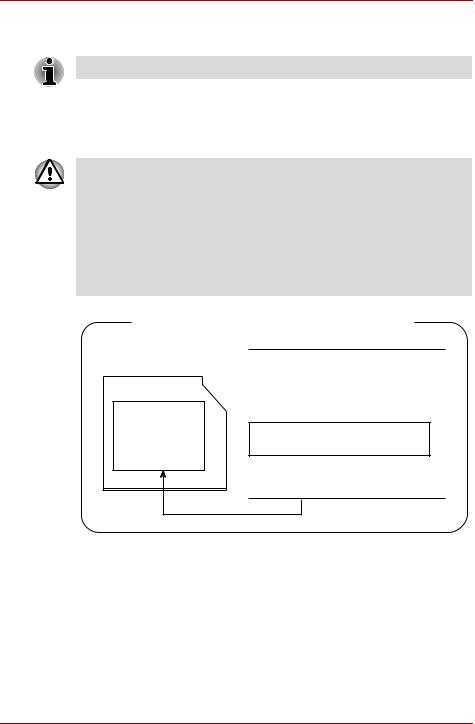
Qosmio F50
Optical disc drive safety instructions
Be sure to check the international precautions at the end of this section.
Panasonic
DVD Super Multi UJ870
■The Super Multi DVD drive employs a laser system. To ensure proper use of this product, please read this instruction manual carefully and retain for future reference.
Should the unit ever require maintenance, contact an authorized service location.
■Use of controls, adjustments or the performance of procedures other than those specified may result in hazardous radiation exposure.
■To prevent direct exposure to the laser beam, do not try to open the enclosure.
Location of the required label
SERIAL NO.
MANUFACTURED:
COMPLIES WITH FDA RADIATION
PERFORMANCE STANDARDS, 21 CFR
SUBCHAPTER J.
CLASS 1 LASER PRODUCT
LASER KLASSE 1
Panasonic Communications Co., Ltd.
1-62, 4-Chome Minoshima, Hakata-Ku
Fukuoka, Japan
User’s Manual |
xviii |
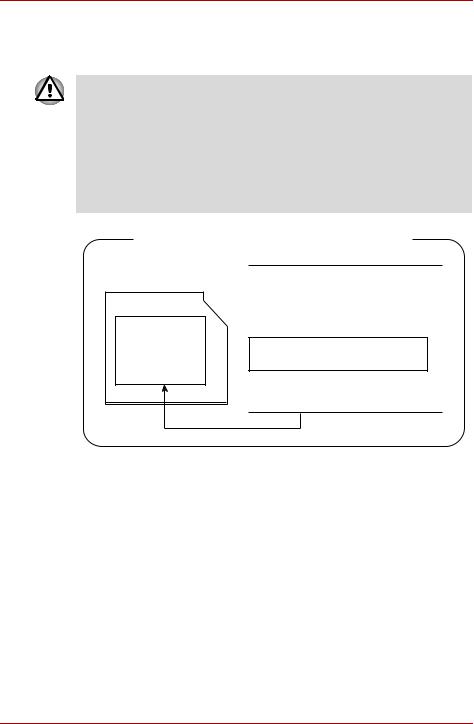
Qosmio F50
Pioneer
Super Multi DVD DVR-TD08TBA/ DVR-TD08TBC
■The Super Multi DVD drive employs a laser system. To ensure proper use of this product, please read this instruction manual carefully and retain for future reference.
Should the unit ever require maintenance, contact an authorized service location.
■Use of controls, adjustments or the performance of procedures other than those specified may result in hazardous radiation exposure.
■To prevent direct exposure to the laser beam, do not try to open the enclosure.
Location of the required label
SERIAL NO.
MANUFACTURED:
COMPLIES WITH FDA RADIATION
PERFORMANCE STANDARDS, 21 CFR
SUBCHAPTER J.
CLASS 1 LASER PRODUCT
LASER KLASSE 1
PIONEER CORPORATION 4-1, MEGURO 1-CHOME
MEGURO-KU, TOKYO, 153-8654
User’s Manual |
xix |
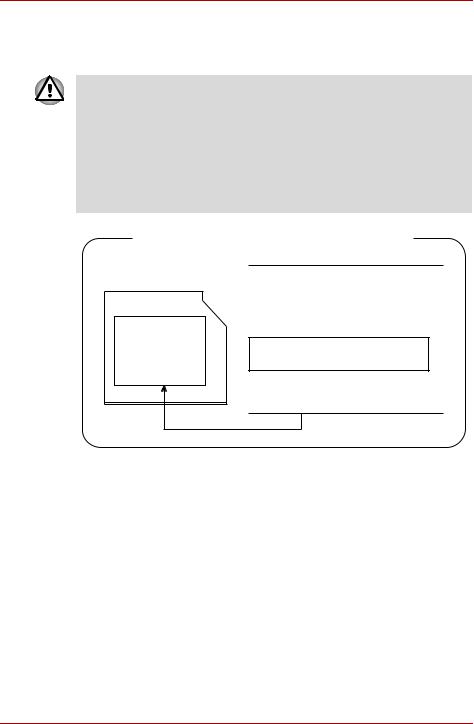
Qosmio F50
Hitach-LG Data Storage
Super Multi DVD GSA-T50N/ GSA-T50F
■The Super Multi DVD drive employs a laser system. To ensure proper use of this product, please read this instruction manual carefully and retain for future reference.
Should the unit ever require maintenance, contact an authorized service location.
■Use of controls, adjustments or the performance of procedures other than those specified may result in hazardous radiation exposure.
■To prevent direct exposure to the laser beam, do not try to open the enclosure.
Location of the required label
SERIAL NO.
MANUFACTURED:
COMPLIES WITH FDA RADIATION
PERFORMANCE STANDARDS, 21 CFR
SUBCHAPTER J.
CLASS 1 LASER PRODUCT
LASER KLASSE 1
Hitachi-LG Data Storage, Inc.
22-23, Kaigan 3-chome, Minato-ku,
Yokyo, 108-0022 Japan
User’s Manual |
xx |
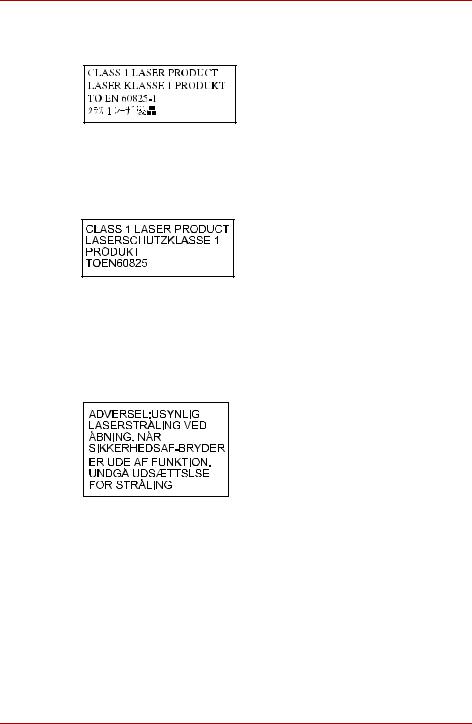
Qosmio F50
International precautions
CAUTION: This appliance contains a laser system and is classified as a “CLASS 1 LASER PRODUCT.” To use this model properly, read the instruction manual carefully and keep this manual for your future reference. In case of any trouble with this model, please contact your nearest “AUTHORIZED service station.” To prevent direct exposure to the laser beam, do not try to open the enclosure.
VORSICHT: Dieses Gerät enthält ein Laser-System und ist als “LASERSCHUTZKLASSE 1 PRODUKT” klassifiziert. Für den richtigen Gebrauch dieses Modells lesen Sie bitte die Bedienungsanleitung sorgfältig durch und bewahren diese bitte als Referenz auf. Falls Probleme mit diesem Modell auftreten, benachrichtigen Sie bitte die nächste “autorisierte Service-Vertretung”. Um einen direkten Kontakt mit dem Laserstrahl zu vermeiden darf das Gerät nicht geöffnet werden.
ADVARSEL: Denne mærking er anbragt udvendigt på apparatet og indikerer, at apparatet arbejder med laserstråler af klasse 1, hviket betyder, at der anvendes laserstrlier af svageste klasse, og at man ikke på apparatets yderside kan bilve udsat for utilladellg kraftig stråling.
APPARATET BOR KUN ÅBNES AF
FAGFOLK MED SÆRLIGT KENDSKAB
TIL APPARATER MED
LASERSTRÅLER!
Indvendigt i apparatet er anbragt den her gengivne advarselsmækning, som advarer imod at foretage sådanne indgreb i apparatet, at man kan komme til at udsatte sig for laserstråling.
User’s Manual |
xxi |

Qosmio F50
OBS! Apparaten innehåller laserkomponent som avger laserstråining överstigande gränsen för laserklass 1.
VAROITUS. Suojakoteloa si saa avata. Laite sisältää laserdiodin, joka lähetää näkymätöntä silmilie vaarallista lasersäteilyä.
CAUTION: USE OF CONTROLS OR ADJUSTMENTS OR PERFORMANCE OF PROCEDURES OTHER THAN THOSE SPECIFIED IN THE OWNER’S MANUAL MAY RESULT IN HAZARDOUS RADIATION EXPOSURE.
VORSICHT: DIE VERWENDUNG VON ANDEREN STEURUNGEN ODER EINSTELLUNGEN ODER DAS DURCHFÜHREN VON ANDEREN VORGÄNGEN ALS IN DER BEDIENUNGSANLEITUNG BESCHRIEBEN KÖNNEN GEFÄHRLICHE STRAHLENEXPOSITIONEN ZUR FOLGE HABEN.
User’s Manual |
xxii |

Preface
Congratulations on your purchase of the Qosmio F50 series computer. This powerful notebook computer provides excellent expansion capability, includes multimedia functionality, and is designed to provide years of reliable, high-performance computing.
This computer family includes a model with a built-in TV tuner. When you wish to display a TV program or play CD/DVD with this model before Windows starts, touch the TV panel or the CD/DVD panel (or the same panels on the remote control) respectively during Windows startup. When Windows is running, you can display or record a TV program using the My TV feature of Media Center.
This manual tells how to set up and begin using your Qosmio F50 computer. It also provides detailed information on configuring your computer, basic operations and care, using optional devices and troubleshooting.
If you are a new user of computers or if you’re new to portable computing, first read over the Introduction and The Grand Tour chapters to familiarize yourself with the computer’s features, components and accessory devices. Then read Getting Started for step-by-step instructions on setting up your computer.
If you are an experienced computer user, please continue reading the preface to learn how this manual is organized, then become acquainted with this manual by browsing through its pages. Be sure to read the Special features section of the Introduction, to learn about features that are uncommon or unique to this computer, as well as the section on HW Setup, to understand how to setup and configure these features.
If you are going to install PC Cards or connect external devices such as a monitor, be sure to read Chapter 9, Optional Devices.
Conventions
This manual uses the following formats to describe, identify, and highlight terms and operating procedures.
User’s Manual |
xxiii |

Qosmio F50
Abbreviations
On first appearance, and whenever necessary for clarity, abbreviations are enclosed in parentheses following their definition. For example: Read Only Memory (ROM). Acronyms are also defined in the Glossary.
Icons
Icons identify ports, dials, and other parts of your computer. The indicator panel also uses icons to identify the components it is providing information on.
Keys
The keyboard keys are used in the text to describe many computer operations. A distinctive typeface identifies the key top symbols as they appear on the keyboard. For example, ENTER identifies the ENTER key.
Key operation
Some operations require you to simultaneously use two or more keys. We identify such operations by the key top symbols separated by a plus sign (+). For example, CTRL + C means you must hold down CTRL and at the same time press C. If three keys are used, hold down the first two and at the same time press the third.
ABC |
When procedures require an action such as |
|
clicking an icon or entering text, the icon's name |
|
or the text you are to type in is represented in the |
|
typeface you see to the left. |
Display
S ABC |
Names of windows or icons or text generated by |
the computer that appear on its display screen |
|
|
are presented in the type face you see to the left. |
Messages
Messages are used in this manual to bring important information to your attention. Each type of message is identified as shown below.
Pay attention! A caution informs you that improper use of equipment or failure to follow instructions may cause data loss or damage your equipment.
Please read. A note is a hint or advice that helps you make best use of your equipment.
User’s Manual |
xxiv |

Qosmio F50
Indicates a potentially hazardous situation, which could result in death or serious injury, if you do not follow instructions.
Terminology
This term is defined in this document as follows:
Start
HDD or Hard disk drive
The word "Start" refers to the "  " button in Microsoft® Windows Vista®.
" button in Microsoft® Windows Vista®.
Some models are equipped with a "Solid State Drive (SSD)" instead of a hard disk drive.
In this manual, the word "HDD" or "Hard disk drive" also refers to the SSD unless otherwise stated.
User’s Manual |
xxv |

General Precautions
TOSHIBA computers are designed to optimize safety, minimize strain and withstand the rigors of portability. However, certain precautions should be observed to further reduce the risk of personal injury or damage to the computer.
Be certain to read the general precautions below and to note the cautions included in the text of the manual.
Provide adequate ventilation
■Always make sure your Computer and AC adaptor have adequate ventilation and are protected from overheating when the power is turned on or when an AC adaptor is connected to a power outlet (even if your Computer is in Sleep Mode). In this condition, observe the following:
■Never cover your Computer or AC adaptor with any object.
■Never place your Computer or AC adaptor near a heat source, such as anelectric blanket or heater.
■Never cover or block the air vents including those located at the base of the Computer.
■Always operate your Computer on a hard flat surface. Using your Computer on a carpet or other soft material can block the vents.
■Always provide sufficient space around the Computer.
■Overheating your Computer or AC adaptor could cause system failure, Computer or AC adaptor damage or a fire, possibly resulting in serious injury.
User’s Manual |
xxvi |

Qosmio F50
Creating a computer-friendly environment
Place the computer on a flat surface that is large enough for the computer and any other items you are using, such as a printer.
Leave enough space around the computer and other equipment to provide adequate ventilation. Otherwise, they may overheat.
To keep your computer in prime operating condition, protect your work area from:
■Dust, moisture, and direct sunlight.
■Equipment that generates a strong electromagnetic field, such as stereo speakers (other than speakers that are connected to the computer) or speakerphones.
■Rapid changes in temperature or humidity and sources of temperature change such as air conditioner vents or heaters.
■Extreme heat, cold, or humidity.
■Liquids and corrosive chemicals.
Stress injury
Carefully read the Instruction Manual for Safety and Comfort. It contains information on the prevention of stress injuries to your hands and wrists that can be caused by extensive keyboard use. Instruction Manual for Safety and Comfort also includes information on work space design, posture and lighting that can help reduce physical stress.
Heat injury
■Avoid prolonged physical contact with the computer. If the computer is used for long periods, its surface can become very warm. While the temperature will not feel hot to the touch, if you maintain physical contact with the computer for a long time, for example if you rest the computer on your lap or if you keep your hands on the palm rest, your skin might suffer a low-heat injury.
■If the computer has been used for a long time, avoid direct contact with the metal plate supporting the various interface ports as this can become hot.
■The surface of the AC adaptor can become hot when in use but this condition does not indicate a malfunction. If you need to transport the AC adaptor, you should disconnect it and let it cool before moving it.
■Do not lay the AC adaptor on a material that is sensitive to heat as the material could become damaged.
User’s Manual |
xxvii |
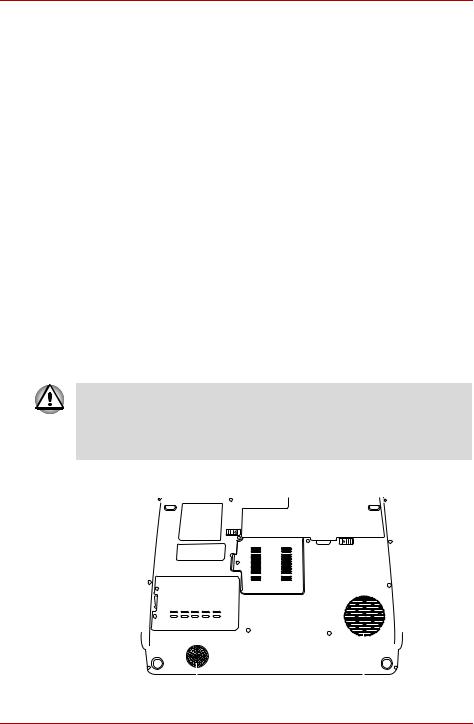
Qosmio F50
Pressure or impact damage
Do not apply heavy pressure to the computer or subject it to any form of strong impact as this can damage the computer's components or otherwise cause it to malfunction.
Mobile phones
Please be aware that the use of mobile phones can interfere with the audio system. The operation of the computer will not be impaired in any way, but it is recommended that a minimum distance of 30cm is maintained between the computer and a mobile phone that is in use.
Instruction Manual for Safety and Comfort
All important information on the safe and proper use of this computer is described in the enclosed Instruction Manual for Safety and Comfort. Be sure to read it before using the computer.
The cautions on use of a Qosmio F50 series computer
1.Clean any dust accumulated on the computer's cooling vents. The cooling vents are located on the back and underside of the computer.
When you use your computer in a dusty area, dirt and debris may accumulate on the cooling vents at the under side of your unit. If this occurs, the accumulated dust can cause insufficient heat dissipation which may result in the computer shutting down during use. Carefully clean the dust from the vents using a vacuum cleaner.
2. Cooling vents on the underside and back of the computer.
|
|
|
|
|
|
|
|
|
|
|
|
|
|
|
|
Sub woofer |
Cooling vent |
||
User’s Manual |
xxviii |

Qosmio F50
The above illustration is of the subwoofer equipped model. Models without the subwoofer have cooling vents in the subwoofer location pictured above. Models with the subwoofer do not have cooling vents in the subwoofer location pictured above.
Cooling vent
Cooling vents
To prevent possible overheating of the CPU, make sure the cooling fan's air intake is not blocked. The fan draws in air by creating a vacuum. If the fan is blocked, it could cause the CPU to run at a lower performance level or cause the computer to shut down. Loose items such as notebook and tissue paper, plastic wrappers, or other similar materials can block the air intake, preventing air from reaching the CPU. Do not use the computer on surfaces with objects that can be drawn in by the cooling fan.
User’s Manual |
xxix |
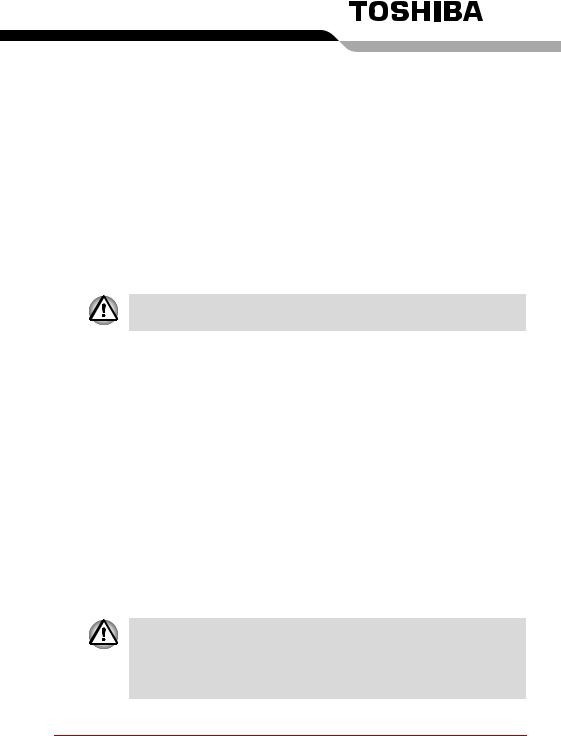
Chapter 1
Introduction
This chapter provides an equipment checklist, and it identifies the computer’s features, options and accessories.
Some of the features described in this manual may not function properly if you use an operating system that was not pre-installed by TOSHIBA.
Equipment checklist
Carefully unpack your computer, taking care to save the box and packaging materials for future use.
Hardware
Check to make sure you have all the following items:
■Qosmio F50 Portable Personal Computer
■AC adaptor and power cord (2-pin plug or 3-pin plug)
■Battery pack (is pre-installed in some computer)
■Infrared transmitter cable
■Remote controller (is included with some models)
■Two AA manganese batteries (for Full size remote controller)
■CR2016 battery (for Slim size remote controller)
■Cleaning cloth (is included with some models)
■FM tuner antenna (is included with some models)
■Some models are included with either a Full size remote controller or Slim size remote controller.
■Use the cleaning cloth to wipe away dust, fingerprints and similar from the keyboard, palm rest and other parts. For precautions on use refer to the Using the cleaning cloth section in Chapter 4, Operating Basics.
User’s Manual |
1-1 |
